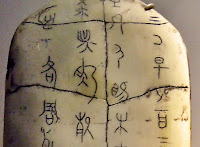Labor Day in Ancient Egypt
Labor Day is a holiday in the United States, and one most of us look forward to celebrating. (Who doesn't like a day off work?) This link is to a post I did last for Labor Day 2015; to be perfectly honest, not that much changed in ancient Egyptian labor practices since last year.
What was it like to be a working man or woman in ancient Egypt?
Not as bad as some might expect. Some workers enjoyed health insurance, free food and lodging, and 2 days off every 10 days. In case you're wondering, a week in Ancient Egypt was 10 days long.
That whole slaves building the pyramid, yeah that's just a story. No Pharaoh was going to entrust his House of a Million Years to disgruntled slave labor. Still, working in Ancient Egypt was no cruise up the Nile either.
ANCIENT EGYPTIAN BREAD, BY MIGUEL ESQUIROL RIOS
Following an old recipe can be challenging. Following a recipe that is not written, but only depicted in pictograms and drawings, archeological examples, and assumptions is even more difficult. The job here is to not only follow the recipe, but also try to understand the culture and traditions where this bread came to be.
In this case, I’m trying to make bread as it was done in ancient Egypt. Bread is not only one of the oldest food staples in many cultures, but it is also a good marker of civilization.
Food: Bread, beer, and all good things
The staple food was bread and beer, supplemented by onions or other vegetables and dried fish.
They eat loaves of bread of coarse grain which they call cyllestis. They make their beverage from barley, for they have no vines in their country.They eat fish raw, sun-dried or preserved in salt brine.
Herodotus
Archaeologist Alain Zivie about the Tomb of Aper-el at Saqqara
French archaeologist Dr Alain Zivie shows some of the findings from the Tomb of the vizier Aper-el, which dates from the latter part of the 18th Dynasty, around 1353-1335 BC and are now stored at the Imhotep Museum at Saqqara.
Ancient Egyptian Farmhouse
Click on the arrow to rotate the farmhouse.
In 1861 Queen Victoria and Prince Albert decided that their 20 year-old son, “Bertie” (Albert), Prince of Wales and future King Edward VII, would benefit from a royal tour of the Middle East. As well as a history lesson, it would offer him the chance to meet many of the rulers in the region – essential training as heir to the throne.
The royal tour was accompanied by acclaimed photographer Francis Bedford, who photographed the touring party and the many sights they took in along the way. Thanks to this, we now have a series of incredible images of 19th century Egypt. When Bertie steamed into Cairo station on the train from Alexandria in March 1862, the first thing he did was jump onto a donkey and ride through the streets of the city!
At the time of Albert’s visit, excavations were still ongoing at Luxor Temple. Today, the colossal statues of Ramesses II standing at the first pylon are visible down to their feet.
[Photos: Royal Collection Trust]









No comments:
Post a Comment
Note: Only a member of this blog may post a comment.